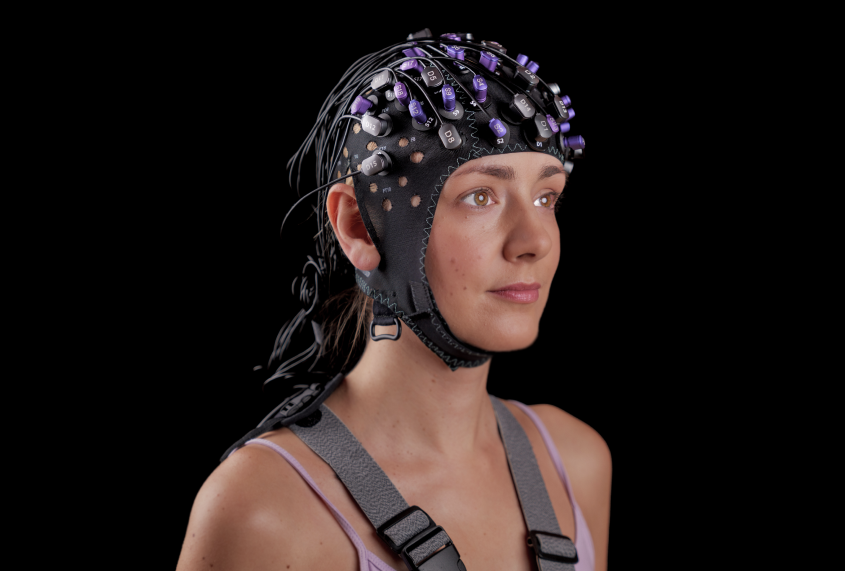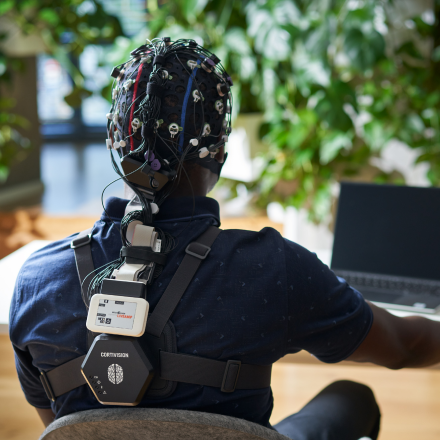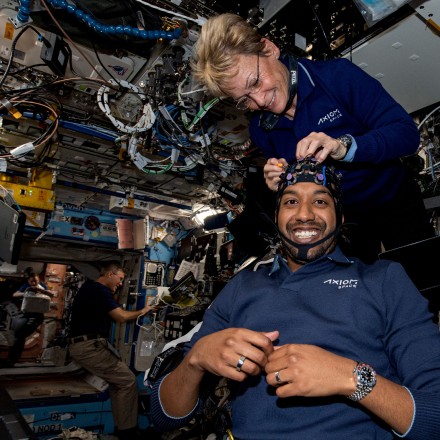About Near Infrared Spectroscopy (fNIRS)
Functional Near-Infrared Spectroscopy (fNIRS) is a non-invasive neuroimaging technology that measures changes in oxygenation levels in the brain. By analyzing these changes, fNIRS provides insights into cognitive functions and neural activity, making it an ideal tool for research in neuroscience, psychology, education, sports, and even space exploration.
To be even more precise functional near infrared spectroscopy (NIRS) is a technique that allows you to monitor the activity of selected areas of the brain by measuring the level of oxygen in the blood flowing through those areas. In simple words we can observe the light penetrating the tissues of our body at any time by placing our hand against the background of the sun or a lamp. The infrared light used in fNIRS penetrates our skull and brain in a similar way.
The actual measurement is carried out with the use of small infrared light sources (LEDs) that emit waves of various lengths towards the brain. Light waves penetrating the tissues are partially absorbed and dispersed, which depends on the amount of oxygen in the blood particles (hemoglobin) flowing through the examined area. By measuring the difference in the parameters of the light sent to the brain and the light that returns to the detectors after it passes through the tissue, we are able to determine the concentration changes:
- oxygenated hemoglobin (HbO2)
- deoxygenated hemoglobin (Hb)
- total concentration of hemoglogin (HbT)
Changes in the concentration of these three parameters allow us to conclude about the oxygen demand of a given area of the brain, and therefore about its activity at the time of measurement.

fNIRS is one of the youngest brain imaging techniques and, unlike other methods, it is:

Thanks to these advantages, it is possible to use fNIRS in non-laboratory conditions, on the move and without constant supervision by the researcher.
-

Brain Computer Interfaces (BCI)
-

Hyperscanning
-

Extreme research conditions
Why Cortivision?
FAQ
-
How the installation of the device looks?
Installing a Cortivision fNIRS system is straightforward and user-friendly. The device comes with lightweight, pre-configured caps and intuitive software. Setup involves placing optodes according to the desired montage, connecting the system, and calibrating using CortiView software. The process is designed to minimize setup time and ensure accurate data collection. Online training is included to guide users step-by-step. -
Do you experience interference due to wireless communication?
No, Cortivision’s fNIRS systems use a dedicated WiFi router included in the package to ensure a stable and interference-free connection. The system transmits data securely and reliably to the recording device, even in environments with multiple wireless signals. Additionally, an onboard SD card provides a backup, ensuring data integrity in any scenario (Spectrum). Wireless communication does not impact the raw signal from brain activity. -
What is your system composed of?
The basis of each of our system is a wireless and fully mobile near infrared spectroscope with dedicated signal recording software. Each fNIRS consist of the amplifer and the optode bundle with textile caps and optode holders. Depending on the version of the device, the set can be extended with additional elements. -
How is fNIRS better than EEG?
There are no superior solutions for all usecases. In neuroimaging area fNIRS is simply a compromise, a golden middle between EEG and fMRI in terms of mobility, spatial resolution and temporal resolution. EEG may be susceptible to interference, difficult in locating the signal source, or less usefull in compatibility of the results with other methods of recording the work of the brain, such as fMRI. By choosing the fNIRS method in our systems, we provide a solution that is free from many EEG disadvantages, and is also fully mobile, easy to apply and applicable outside laboratory conditions. -
What is fNIRS channel?
Unlike EEG, a channel in fNIRS is a space between the emitter and the detector. This is not a single spot. This also means that one detector can form channels with multiple emitters. -
Why I haven't heard about fNIRS so far?
FNIRS is the youngest method when it comes to studying the work of the brain and due to its advantages (mobility, resistance to interference, accessibility), in recent years there has been a significant increase in the interest of professionals from various fields of science, medicine and business. -
What brain structures can be monitored with fNIRS?
Currently, the fNIRS technology enables the registration of the signal source from the areas of the cerebral cortex with an accuracy of ~ 2 centimeters. Access to deep structures is limited. You can read more about how the signal is recorded with fNIRS and the accuracy of this method in the article: Pinti, P., Tachtsidis, I., Hamilton, A., Hirsch, J., Aichelburg, C., Gilbert, S., & Burgess, P. W. (2018). The present and future use of functional near‐infrared spectroscopy (fNIRS) for cognitive neuroscience. Annals of the New York Academy of Sciences. doi: 10.1111/nyas.13948 -
Can I test the device?
There are two possible ways to test our devices. One is our CortiVision Pathfinder Program which provides a unique opportunity for access to our fully portable and wireless fNIRS Ecosystem CortiVision Photon. CPP participants will receive a Photon Cap spectroscope and full assistance from Cortivision experts to realize their research projects. This program aims to generate relevant scientific outcomes and share the results in high-quality journals or conferences. The CPP includes providing feedback to Cortivision for further evolution of the Photon ecosystem and documenting the project’s results. More details: https://www.cortivision.com/pathfinder/ The second option is to contact our local distributor who can prepare a product demonstration at your place of work. For details contact our distributors. -
Is fNIRS safe?
FNIRS is a non-invasive method of examining the work of the brain. This means that the tissues of the examined person are not damaged during registration. So far, no negative impact of the use of near infrared spectroscopy on the human body has been found. Always use the device in accordance with the user manual. -
How can I purchase it?
Please find the General Terms and Conditions of Sale here: https://www.cortivision.com/gtcs/. Acceptance of the conditions of sale is necessary to complete the order. The basis for the execution of the order is to fill out an order form, in which basic information about the buyer should be indicated, including the number of the quotation received. Based on these a proforma invoice is issued. Depending on the contents of the order, the order queue and the market situation, products are delivered within a few days or a few weeks. A final invoice is delivered with the product.
